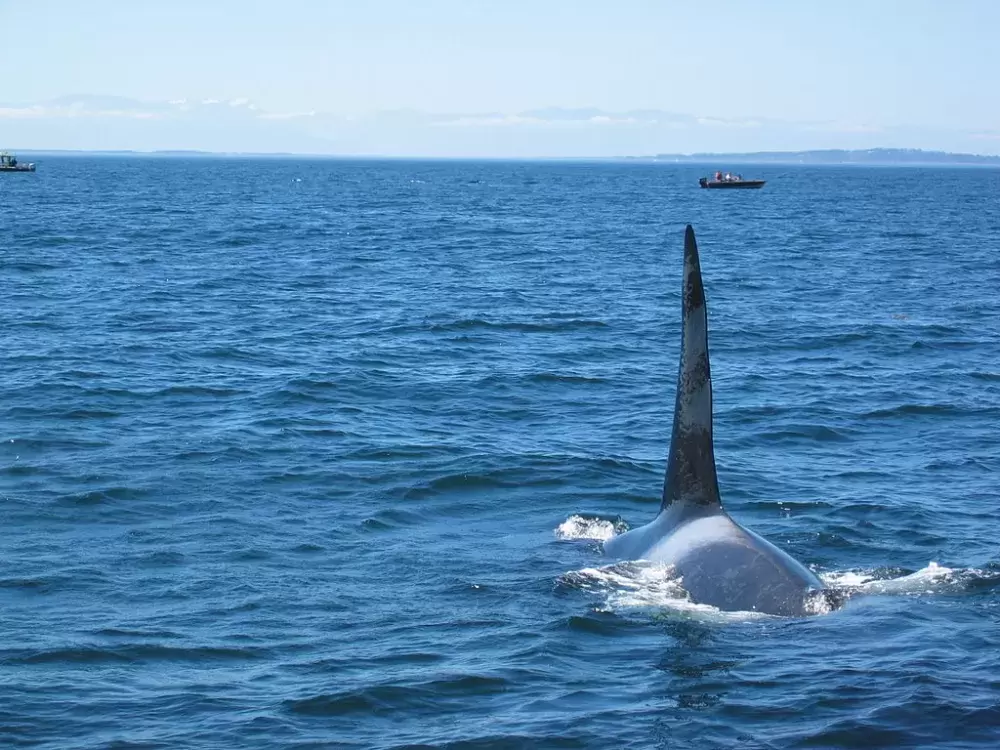The Southern Resident Killer Whale population has been listed as endangered under Canada’s Species at Risk Act (SARA) and by the Committee on the Status of Endangered Wildlife in Canada (COSEWIC) since the early 2000’s. With only 76 individuals remaining facing so many obstacles on their path to recovery, it has been determined that even if their numbers were to improve, we won’t see it for at least 25 years. That is what Jared Dick, Central Region Biologist for NTC Fisheries (Uu-a-thluk), reported to the Council of Ha’wiih on Feb. 15 and 16 after attending the Southern Resident Killer Whale Symposium held in Victoria, B.C. last October.
Dick reports that the Southern Resident killer whale population has consistently declined since the 1990’s. The Southern Resident Killer Whale is one of four populations of orca on the west coast of British Columbia. The other three are known as Offshore, West Coast Transient and Northern Residents. They each have their own range and preferred diet.
According to Population Trends of Southern Resident Killer Whales from 1960 – 1999, a report by David E. Bain and Kenneth C. Balcomb III, the Southern Resident Killer Whale population was estimated to be 100 in the mid 1960’s. Their numbers started to decline during the early 1970’s as a result of a live capture fishery that supplied whales to aquariums for public display. The report goes on to say that after live capture stopped during the mid-1970’s the population of Southern Residents stood at about 70 individuals.
Over the next 20 years the population rebounded to about 98 individuals but before the end of the century their numbers steadily declined. In 1999 there were 83 Southern Resident killer whales; today there are an estimated 76 whales remaining.
There are many reasons for the decline of the Southern Resident killer whale population and most are related to human activity, including fishing, boat strikes and pollution.
Critical habitat for the Southern Resident killer whales includes the Strait of Juan de Fuca, in the area of southern Vancouver Island and Puget Sound. The proximity of the whales’ habitat to large urban centers, such as Seattle, Victoria and Vancouver, has led to more frequent collisions with boats and exposure to significantly higher numbers of oil spills and other pollutants.
Recent studies have found that Southern Resident killer whales are contaminated with high levels of toxic chemicals such as organochlorines, making them susceptible to disease and reproductive difficulties.
Water pollution also affects species on which the whales feed, leading to reduced food supply.
It’s also possible that the large and growing recreational whale watching industry may be having a negative impact.
Given their low reproduction rate, even under the most optimal circumstances the recovery of the southern resident killer whale population will be slow.
“It would take more than one generation, 25 years, in the best of circumstances for improvement to show,” said Dick.
The best of circumstances would mean protecting the habitat from pollution, including noise pollution, finding ways to protect the whales from boats and improving their food supply.
While killer whales have a varied diet that includes squid, sea turtles, sea lions, other whales, dolphins, otters and even birds, the Southern Resident killer whales feed mainly on fish, especially the dwindling Chinook salmon.
It was reported at the Council of Ha’wiih meeting that Chinook returns to the Salish Sea dropped from 1.2 million in 1984 to 500,000 in 2010. Even more alarming, the bigger six and seven year-old fish can no longer be found. “They (whales) must expend more energy to look for smaller pieces of food,” said Dick.
So, now that the risk factors are known and most of the SR killer whale’s critical habitat is identified, DFO has released their recovery strategy for both the Northern and Southern Resident killer whales.
The 72-page document indicates that the goal is to ensure the long-term viability of resident killer whale populations by maintaining demographic conditions that preserve their reproductive potential, genetic variation, and cultural continuity.
In order to achieve this goal, DFO has identified four objectives:
- Ensure that resident killer whales have an adequate and accessible food supply to allow recovery.
- Ensure that chemical and biological pollutants do not prevent the recovery of resident killer whale populations.
- Ensure that disturbance from human activities does not prevent the recovery of resident killer whales.
- Protect critical habitat for resident killer whales and identify additional areas for critical habitat designation and protection.
These initiatives are part of the Government of Canada’s $1.5 billion Oceans Protection Plan, a national strategy to create a world-leading marine safety system while protecting coastlines for future generations.
So far, there has been some movement to mitigate threats to the whales, including the development of whale watching guidelines in Canada and enforcement of whale watching regulations in the US. There have been improvements in ocean disposal of sediment and guidelines have been established in Canada for the use of PCBs, and bans or restrictions on certain contaminants in both countries.
However, no recovery measures have been implemented that directly aim to reduce shipping noise or improve prey availability for SRKWs. All stakeholders agree that it is critical that SRKW be provided greater access to prey in their key foraging areas. This may be achieved by either by increasing the abundance of the prey or by reducing underwater noise so they forage more effectively, or a combination of both.
During the Council of Ha’wiih meeting Nuchatlaht Councillor Archie Little said it’s a huge issue and First Nations are not being consulted. He demanded better management of Chinook fisheries that would include closure of the recreational fishery until the stocks show significant improvement.







